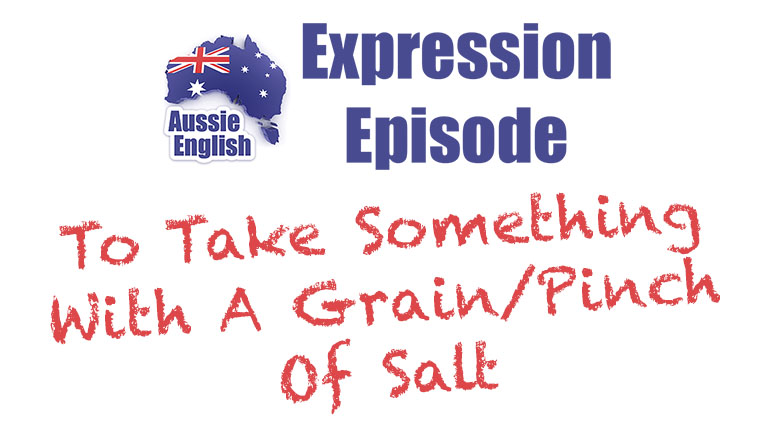AE 465 – Expression: Take It on the Chin
Learn Australian English in this expression episode of the Aussie English Podcast where I teach you to use the expression TAKE IT ON THE CHIN like a native speaker.
AE 465 – Expression: Take It on the Chin
G’day, guys! What’s going on? Welcome to this episode of the Aussie English Podcast, the number one podcast for anyone and everyone wanting to learn Australian English. So, whether you want to learn Australian English or just English in general it’s all the same thing really, apart from maybe the odd slang term or expression, but I’ll let you know, I’ll let you know if I use some. But this is the podcast for you guys, and it is brought to you by The Aussie English Classroom. That is my online classroom with all the extra content specifically made so that you can work through it bit by bit to improve your English if you like to study and if you want to learn more, if you want to do more, if you want to partake in activities instead of just listening to the podcast, that is the place to go for you, and that is TheAussieEnglishClassroom.com and it’s just one dollar at the moment for your first 30 days so you’ve got plenty of time to give it a go.
On top of that, guys, if you want the transcripts only and the MP3 for these podcast episodes, you can go to theAussieEnglishPodcast.com and you can sign up there for a small monthly fee. It’s about a bit under five bucks in order to get access to or transcripts. Anyway, let’s get into today’s episode.
So, that intro scene at the start there was from the Rebel Films a YouTube channel. There will be a link in the transcript to their channel as well as this video. And it was a Pitjantjatjarra woman named, and I’ll see if I can do this right, Nganyinytja. Hopefully I said that right. A Pitjantjatjarra a woman named Nganyinytja from South Australia, and she was speaking about what it was like as an Australian aboriginal living in this area of South Australia in the desert before she had ever met a white man. So, many aboriginals in Australia didn’t lay eyes on, let alone meet, a white person until the mid-20th century.
So, go check that video out if you want to hear a bit of Australian Indigenous language being spoken as well as if you want to understand a bit more about what it was like being an Aboriginal in Australia before meeting white men.
Anyway guys, as usual, let’s go through an Aussie joke. So, the Aussie joke for today guys, are you ready? Are you ready? Are you buckled in? Are you prepared? The joke is:
Did you hear about that guy whose whole left side was cut off? Did you hear about that guy whose whole left side was cut off?
He’s all ‘right’ now. He’s all ‘right’ now.
Do you get it? Do you get it? So, it’s a pun here, guys. He’s all ‘right’ now. Did you hear about the left side, the left side, of this guy and how it was cut off? Now, he’s all ‘right’. So, that’s a joke there between left and right, right? Left and right. But then also, if you’re ‘all right’, especially after an accident, it means that you’re okay, you’re all right. Okay? So, I hope you get that one.
Today’s expression, guys, is ‘to take it on the chin’, ‘to take it on the chin’, and this one was suggested by Emma in the Aussie English Classroom Facebook group. We’re in their every week suggesting expressions and then we vote on them. Emma won this week’s. Well done Emma. Next week, good luck Aykhan. He keeps trying to win, but people keep beating him. So, come on Aykhan. You got this! Next week! We can do it!
So, let’s go through and define the different words in this expression first, guys. We’ll go through the definition and origin of this expression. I’ll give you a couple of examples. We’ll then go through a listen and repeat exercise. And then, I want to chat to you a little bit about Australian Aboriginal languages just so that you guys understand a little bit more about the diversity of languages in Australia.
Alright. So, definitions wise. The first one, the first word, in this expression ‘take’, ‘take’. This is one of those verbs that has many different meanings, but I’m sure you’re familiar with the word, or the verb, ‘to take’. ‘To take something’, though, in this case, ‘to take something’, ‘take it’, is to receive or accept something. To receive or accept something. You’re taking something. So, if someone tries to give me something, or maybe it’s not even being given, they’re just doing this thing to me, if I take it, I receive it, I accept it.
The word ‘it’. I’m sure you guys know ‘it’. I’m sure you know this word. It is the singular gender-neutral pronoun in English.
The word ‘on’. ‘On’ is, in this case, talking about the location of somewhere in the general surface of an area. So, in this case, it’s ‘on’ the chain. You are taking something, you’re receiving something, and then we’re using ‘on’ to talk about the surface on which you’re receiving this thing, which is a punch just so that you know. To take it on the chin. To take a punch on the chin.
The last word here, ‘a chin’. ‘A chin’ is the bottom of your face. It is under your lower lip. It is the protruding part of the face below the mouth, and it’s formed by where the two lower jaws meet in the middle.
Okay? So, those are the words.
Let’s go through the expression now, guys. So, the expression ‘take it on the chin’. I wonder if you guys have heard this and if you know how to use it. It’s got a few different meanings. The first one is a literal meaning, obviously, most expressions seem to have come from something literal originally. In this case, the literal meaning of ‘to take something on the chin’ is to receive an impact, especially a punch, obviously, on one’s chin. To receive a punch on the chin.
Figuratively, though, it is to endure hardship, difficulty, setback, defeat, especially when you do it with stoic courage or poise. Okay? So, to receive or suffer the full brunt or defeat of something, a setback, a difficulty, a hardship. And it’s that idea, I guess, of being punched in the face, when we’re talking about this literally. If you take it, if you accept it, if you don’t complain, if you get on with it, if you be strong, you be a man, you accept the challenge, you’re taking it on the chin. Okay?
So, the origin of this expression. It comes from the early 1900s. So, you know, it’s probably about 100 years old, if that. The phrase obviously comes from boxing and generally denotes a direct or significant hit most literally from an uppercut, which is where you drop your arm and it comes upwards to hit the bottom of the jaw. Okay? So, that’s where this comes from.
Let’s go through some examples now though, guys, of how I would use ‘to take it on the chin’ when I speak with people in English.
So, number one. Okay, the literal version. Imagine you’re a boxer. Okay? You’re a boxer. You like to fight. You’ve got a match against a formidable opponent who you’d like to defeat. You train incredibly hard leading up to this match in preparation. However, when the match comes around and you have to fight this guy, he just ends up being too good. His footwork is amazing. He’s quicker than you. He’s nimble. He’s got incredibly quick reflexes, which are sharper than yours. He’s out-moving you. He’s out-punching you. He’s out-boxing you. So, imagine you get hit with a jab, and then you get hit with a straight, and then finally, he gives you an uppercut square to the jaw and knocks you out. You get KOed. If you wake up, you realise you’ve been defeated, the referee picks you up, he holds up your opponent’s hand and announces that he’s the winner, and that you’re the loser, unfortunately. You hug your opponent, you congratulate him on his victory, and then you think, “How can I improve? What can I do? What did I do wrong? What can I do better next time?”. If you do all these things, you’re taking the loss on the chin. You’re taking the loss on the chin. So, you’re not being a sore loser. Despite losing, despite facing significant hardship, you’re being strong, you’re being a man, you’re accepting the loss, you want to learn from it, you’re taking it on the chin. You took it on the chin both literally and figuratively.
Example number two. This time imagine that you go to work one day and you find out that the business has tanked. Okay? So, it hit rock bottom. Maybe there’s a downturn in the economy. Maybe people just aren’t buying the services or the products from this business and the company isn’t as successful as it once was. So, as a result of the poor performance of this company your boss has to tell you that you’re being made redundant, meaning that the company can’t afford to keep you hired anymore. They have to let you go. It’s not that you’re being fired, but you’re not quitting either. But the position that you have at work is no longer available. So, you are being made redundant. If you take this on the chin, you’re being stoic. You understand it’s not their fault, it’s not your fault, it’s just how it is, and you accept things, and you stay strong, you get on with the job, you keep a positive attitude, you take it on the chin. So, someone might say if they hear about this, “Wow! You’re doing really well. You’re taking it on the chin.”.
Example number three, guys. Alright, so imagine that your mother is a gambler, so she likes to bet money, she’s addicted to gambling. So, imagine she goes every night to the pokies at a pub around the corner. She wanders off in the night after dinner, disappears, and then comes back and she’s pissed away a lot of the family’s money, a lot of the family’s hard-earned money. Eventually things go too far, your mother takes it too far and your father finds out what’s happened and realises that the family’s money is all gone, and it’s him and the children who have to take it on the chin. It’s the kids and the father, they’re the ones who now have to suffer as the result of the mother’s gambling, they have to endure this hardship, they have to take it on the chin, they have to be strong, they have to get on with things, they have to deal with this bad situation, they have to take it on the chin. If the family turned to the mother and told her off, you know, reprimanded her, and she got her act together and tried to fix things, she stopped gambling, she’s accepted it was her fault and that she needs to make amends, now she’s taking it on the chin. When your mum admitted she’d done something wrong, she really took it on the chin. Okay?
So, hopefully now you guys understand the expression ‘to take it on the chin’, ‘to take something on the chin’. Remember, literally, it means to take an impact especially a punch on one’s chin.
But figuratively, it is to endure a hardship, some difficulty in life, a setback, a defeat, and especially, when you face this with stoic courage and poise. Okay?
So, now let’s go through a little listen and repeat exercise, guys. This is your chance to practice your Australian pronunciation or just your English pronunciation in general. Remember, listen and repeat after me, guys. Let’s go.
To
To take
To take it
To take it on
To take it on the
To take it on the chin x 5
Good job, guys. Now, ‘take’. ‘Take’ isn’t a regular verb. “I took it on the chin”, “I’ve taken it on the chin”. Okay? So, it has two different past participles, “took” and “taken”. So, in this exercise now, I want you to practice the Present Perfect “have taken it on the chin”, okay, and we’ll go through the different pronouns. Let’s go.
I’ve taken it on the chin
You’ve taken it on the chin
She’s taken it on the chin
He’s taken it on the chin
We’ve taken it on the chin
They’ve taken it on the chin
It’s taken it on the chin
Great work, guys. Now remember, if you would like to go more in depth with all the connected speech and the pronunciation, the secret tips and tricks, for what I’m doing here as a native speaker when I pronounce these phrases, remember you can sign up to the Aussie English Classroom. You will not only get access to this episode and the breakdown of the pronunciation in this exercise, but you will get all the previous episodes as well, and I’m currently working on a pronunciation course in the Aussie English Classroom. So, it’s full of videos. I’m about to upload, and exercise’s, MP3s for all the different sounds in English, as well as the minimal pairs, and it’s specifically for people who want to improve their Australian accent. So, get in there and give it a go. TheAussieEnglishClassroom.com.
All right, guys, let’s go through the Aussie Fact and we will finish up.
So, Australian Aboriginal languages. There was once estimated to be between 290-363 languages belonging to 28 language families and isolates spoken by Australian Aboriginals on the mainland and nearby islands of Australia. So, relationships between these languages still aren’t very well clearly understood and much is still yet to be learnt about these languages. But one thing that does blow my mind every time I learn about these indigenous languages was just how much diversity there was in these languages. So, 28 language families. 28! That’s astonishing. And if we consider, say, the language family that English is from, to put that in context and make you realise how diverse language families can be, the Indo-European languages in the Indo-European language family go from languages like Hindi, Russian, English, Gaelic in Ireland. All of these languages are still part of the same family. Whereas, different families would be languages like Arabic, that’s a different family from English, or Chinese, that’s in a different language family as well. So, 28 of these language families are in Australia for indigenous languages.
By the end of the 18th century, there were only 250 or so languages and varieties remaining. So, we lost quite a lot in the first hundred years of colonisation. And then at the start of the 21st century, there were fewer than 150 languages still used on a daily basis. So, potentially less than half the original diversity of languages in Australia is still being used on a daily basis.
The majority of Australian Aboriginal language diversity is found in northern Australia centred around Arnhem Land in the Northern Territory and the Kimberley region in Western Australia. So, that is where, I believe, 27 of the 28 language families are found in that small area in northern Australia. The remainder of Australia, the vast majority of the Australian continent, is just one language family, the Pama-Nyungan language family. And crazily enough, this family includes 300 languages, as many as 300 languages.
The majority of Australian languages are now highly endangered and only 13 or so are being transmitted to children being taught to children. Of the five least endangered Western Australian Aboriginal languages, four belong to the Ngaanyatjarra grouping of the Central and Great Victoria Desert.
So, that’s a little bit of an introduction to the state of languages in Australia, the indigenous languages, guys. I definitely recommend checking out that video from the start if you would like to learn a bit more about indigenous languages, how they sound. Definitely get on Google and have a look, and learn a bit more if it interests you.
Anyway, thanks so much for joining me today, guys. I hope you enjoy this episode and I will chat to you soon. Enjoy your weekend, guys. See ya!
Here's what you get when you sign up!
- Read while you listen using the Premium Podcast player.
- Understand every word in every episode.
- Download all PDF transcripts and MP3s for 600+ episodes.
- Get access to bonus member-only episodes.












Responses